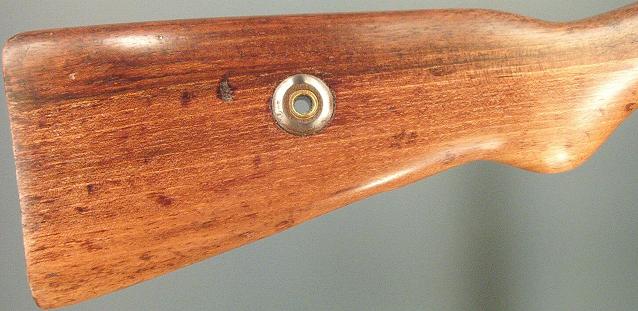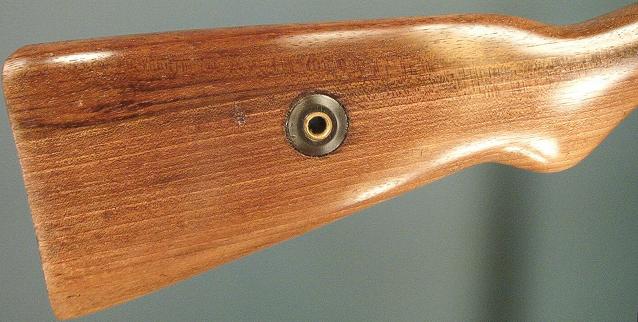The upper handguard, made of Beech I believe, will be shown before cleaning and shown after each of the following finishes have been applied:
1. Boiled Linseed Oil
2. Tung Oil/Varnish (Minwax Tung Oil Finish)
3. Pure Tung Oil
4. Linseed Oil/Varnish (Minwax Antique Oil Finish)
5. Boiled Linseed Oil (Confirmation Finish)
6. Linseed Oil/Varnish (Final Finish) (Minwax Antique Oil Finish)
Note that the handguard is cleaned before each above finish is applied using all the Thorough Cleaning Methods described at Gun Stock Cleaining. The finishes are applied in the order given to demonstrate the effectiveness of the Thorough Cleaning Methods and because the final finish on this gun stock will be the Linseed Oil/Varnish Finish.
The Boiled Linseed Oil and Pure Tung Oil finishes are applied as described at Gun Stock Oil Finishing. The Tung Oil/Varnish Finish is applied as given in the Minwax Tung Oil Finish directions and the Linseed Oil/Varnish Finish is applied as given in the Minwax Antique Oil Finish directions.
Before Cleaning
The photo below shows the handguard before any cleaning:
There is an inspection marking (cartouche) in the middle of the upper rail that consists of the letter 'C' that is facing upward in these photos. Notice the color of the wood is relatively consistent but the wood grain is not very apparent.
Boiled Linseed Oil Finish
The photo below shows the handguard finished in Boiled Linseed Oil:
Note that the inspection marking is visible but all bruises in the wood are also visible as darker areas. Because these bruises are so apparent, the result looks worse than before it was cleaned.
Tung Oil/Varnish Finish
The photo below shows the handguard finished in Minwax Tung Oil Finish:
Note that the inspection marking is barely visible but bruises in the wood are also much less pronounced.
Pure Tung Oil Finish
The photo below shows the handguard finished in Pure Tung Oil:
Note that the inspection marking is visible but bruises in the wood are also visible as slightly darker areas.
Linseed Oil/Varnish Finish
The photo below shows the handguard finished in Minwax Antique Oil Finish:
Note that the inspection marking is slightly visible and bruises in the wood are much less pronounced than when Boiled Linseed Oil or Pure Tung Oil is used.
Boiled Linseed Oil Confirmation Finish
The photo below shows the handguard once again finished in Boiled Linseed Oil:
This confirmation finish was applied to confirm that after all the above finishings, the handgard appears similar to as it did after the first finish and, therefore, that no variations in the finishes applied were due to additional cleaning and sanding. It may be worthy to mention that, for this finish, instead of 24 hour drying times between these applications, only 8 hour drying times were used. Note that the inspection marking will be avoided during the cleaning for the final finish below to permit the marking to be more visible with this Oil Finish under the final Oil/Varnish Finish below.
Linseed Oil/Varnish Final Finish
The photo below shows the handguard finally finished in Minwax Antique Oil Finish:
Note that the inspection marking is much more visible than it was with the previous Oil/Varnish Finish. This is because, as explained in the previous section, the Oil Finish of the marking was retained by being avoided during the cleaning for this final finish.
Example Of Stock Finished In Oil And Oil/Varnish Finish
The examples below show the results of finishing the stock of the Mauser in Boiled Linseed Oil and finished in Linseed Oil/Varnish. This portion of the stock makes an excellent demonstration example because there is both light and dark grains in this section of the stock.
The photo below shows the stock finished in Boiled Linseed Oil:
The photo below shows the stock finished in Linseed Oil/Varnish Finish:
Recommendations
There are basically four options to select from when Oil Finishing a gun stock as follows:
If the gun is to remain authentic and as original as possible, the original finish used is recommended. Note, however, that bruises in the wood may possibly appear darker after any Boiled Linseed or Pure Tung Oil is applied.1. Refresh/Renew Existing Finish
2. Improve Existing Finish
3. Strip And Refinish As Original
4. Strip And Refinish As Improved Original
If it is acceptable to improve the existing finish, the Oil/Varnish Finish using the oil that the original finish consists of is recommended. The Oil/Varnish Finish is an improvement over the Oil Finish because these finishes prevent bruises from darkening and because these finishes prevent dirt, oils, and moisture from penetrating the wood surface.
If the stock is to be stripped and refinished as original, it is recommended to use the original finish used and/or the Oil/Varnish Finish. Note, however, that the Oil/Varnish Finishes may also cause faint markings (cartouches) to not show well. Therefore, it is possible to first finish the markings in Oil Finish followed by the Oil/Varnish Finish.
As indicated in an email message from Minwax, regarding their Tung Oil/Varnish (Minwax Tung Oil Finish) and Linseed Oil/Varnish (Minwax Antique Oil Finish):
"Both finishes are penetrating, oil-based, hand-rubbed finishes. The Tung Oil Finish is derived from oil extracted from the tung nut blended with an alkyd varnish resin. The Antique Oil Finish is derived from linseed oil blended with an alkyd varnish resin. Both finishes create a natural feel and appearance to wood (protection lies within the wood grain not on top of the wood). Overall, the Antique Oil Finish is a more durable finish and will have a softer look to the finish." It is important to remember that once an Oil/Varnish Finish is applied, only that finish should be used to refresh/renew the finish. Do not apply an Oil Finish on top of an Oil/Varnish Finish because the Oil Finish will be repelled by the Oil/Varnish Finish and will result in a gummy finish.








